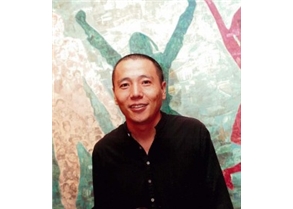XUE, SONG
Calligraphic works and figurative paintings by the Shanghai artist Xue Song are characterized by a bold and energetic style. Both his figures and Chinese characters have clearly defined outlines and are superimposed on an intricate collage of hundreds of fragments of printed paper. Xue Song’s trademark collages represent the many different aspects of Chinese culture; for example, he incorporates traditional Chinese paintings, ancient calligraphy, folk art, religious icons, legendary figures and historical photographs. Through these classic images, Xue Song makes deliberate and specific references to Chinese history, society, politics and art.
Many of the fragments of paper in Xue Song’s collages have burnt edges, a feature of his work that originates in the tragic destruction of his studio by fire several years ago. All that remained from the blaze were charred fragments of paintings and piles of ash. To cope with the pain of his loss, Xue Song retrieved these remains and pasted them onto canvas. For him, ash is both a reminder of fate and a symbol of rebirth. Ever since, he has painstakingly burned the edges of the paper fragments in his collages. The main figures or characters in his painting are executed in a mixture of burnt wood ash and glue, resulting in a rough texture that contrasts with the smooth glazed collage background.
In the past, Xue Song has taken inspiration from a number of master painters, both Western and Chinese. His "Talk with Masters" series consisted of pastiches of artists including Picasso, Mondrian, Yves Klein, Franz Kline, Jasper Johns, Zhang Daqian, Liu Haisu, Qi Baishi and Xu Beihong. Other paintings have featured large silhouettes making iconic references to famous Western and Chinese political figures.
Recently he has been inspired by the "New Interpretation of Classic Poems" series of paintings by the artist Feng Zikai (1898-1975), considered the founder of modern cartoons in China. Feng was a close observer of nature and children, and was sympathetic to ordinary people. Xue Song imitates Feng’s style and themes perfectly, the cartoon-like black outlines providing an intriguing contrast with his collages. His message seems to be that the morals of the ancient verses, reinterpreted first by Feng Zikai and now by himself, have persisted through the centuries.
Currently, Xue Song’s chief interest is calligraphy, which of all the genres of Chinese art he believes has achieved the highest level. He admires calligraphy for its pictorial and rhythmic qualities, and also for its centuries-old history. Some of Xue Song’s calligraphic paintings consist of well-known verses, or individual legible characters. In others, the characters are either incomplete or impressionistic: here he is simply exploring the possibilities of the form, structure and energy of Chinese calligraphy, in other words, using calligraphy as a form of abstract painting. A thoughtful and intellectual artist, Xue Song shows respect for Chinese tradition, while thinking about which direction Chinese calligraphy should take nowadays.
|
 |
| Country of Origin |
|
| |
 |
|
|
|